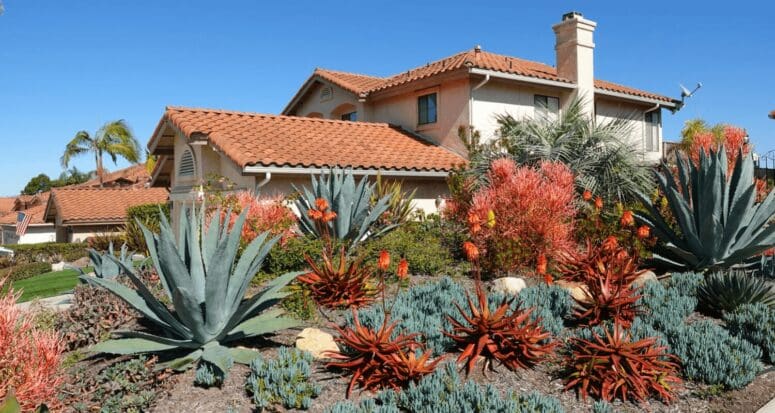10 Eco-Smart Ways to Add Curb Appeal in Dry, Desert Climates
- Published on
- 8 min read
-
 Christine Bartsch Contributing AuthorClose
Christine Bartsch Contributing AuthorClose Christine Bartsch Contributing Author
Christine Bartsch Contributing AuthorFormer art and design instructor Christine Bartsch holds an MFA in creative writing from Spalding University. Launching her writing career in 2007, Christine has crafted interior design content for companies including USA Today and Houzz.
What do you imagine when you picture a front yard with perfect curb appeal? If you live in the desert, you don’t envision the typical rolling green lawn, lush and leafy trees, and manicured hedges. Watering that amount of foliage in the desert would get expensive fast, especially in the summer months where desert temps regularly hit 110 degrees F or higher in Southwest states that get little rain annually.
Across the nation, the average annual rainfall is 30 inches, but desert cities like Phoenix, Arizona only get around eight inches of rain annually. That’s why up to 70% of household water usage goes toward landscaping in desert states, compared to 30% in other regions. And unfortunately, a lot of that water is going to waste due to inefficient watering plans.

When you go to sell your house, this can feel like a dilemma: Will buyers even look at your house if it doesn’t have the traditional American lawn? Thankfully having great curb appeal in the desert doesn’t have to be expensive, or harmful to the environment. There are lots of sustainable ways to maintain your greenery. Plus, there are plenty of desert landscaping ideas that don’t require water at all.
“You don’t have to be a landscape designer to improve your desert landscaping,” says Charlotte Trone, a top-selling agent in Albuquerque, New Mexico. “You can add some small potted trees or plants, put in a small fountain, or break up the landscaping with a dry creek bed made with river rock. Little additions like these add interest and it’s really easy to do.”
Let’s look at the top 10 eco-smart ways to rescue your desert landscaping’s curb appeal while protecting the environment, too:
- If you’ve got a lawn, water wisely
- Goodbye grass, hello faux!
- Get your color pop from different rock varieties
- Xeriscape with drought-resistant greenery
- Skip bushes and trees that drop fruits and leaves
- Add drama with elevation
- Install a water feature
- Feature a no-water riverbed
- Create a serene seating area
- Don’t go crazy with kitsch

1. If you’ve got a lawn, water wisely
It’s not impossible to grow grass in a desert climate—and you don’t need to waste water to keep it green if you’re smart about your watering schedule.
If you’re planting new grass, look into drought tolerant seed and sod as they’ll require less water to maintain.
If you’re maintaining an existing lawn, rather than watering in the afternoon, when intense sunlight speeds evaporation, be an early bird and water at sunrise when heat and sun intensity are low. Better yet, wait until after dark, when the sun won’t be a factor at all.
How long you let your sprinklers run needs attending to as well.
It’s not enough to simply go with the manual guidelines or the factory settings. You need to take steps to test your sprinkler’s output, how much water your lawn type actually needs, and how frequently watering needs to happen.
Once you’ve determined how long you need to water, and how frequently, don’t just set it and forget it with your sprinkler systems. Continue your water conservation efforts year-round by adjusting your sprinkler output seasonally.
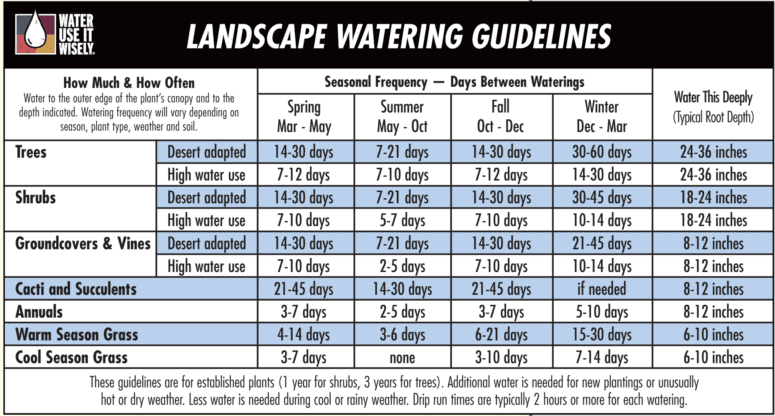
After all, it just makes sense that lawns need less water during the cool winter months.
2. Goodbye grass, hello faux!
While front yard lawns may be standard in many parts of the country, desert regions are the big exception.
“Here in New Mexico, a lot of houses don’t have any grass at all, especially new builds. However, artificial grass works well in small areas if you still want that lawn look in the front yard,” says Trone.
“You probably wouldn’t want to install it across the whole front lawn, as it does require upkeep, and it can get kind of ratty if not maintained. But installing it small areas is a great way to add a little green into your curb appeal.”
A small patch of lush faux grass defined by a border of bricks or river stones may be just the pop of color needed to improve your desert yard’s curb appeal. Envision the size and shape of a curvy putting green.
And the best part is, you won’t ever have to cut your faux lawn or water it to make it grow. It’s not completely maintenance free, though.
You’ll need to brush down your faux grass frequently, and even rinse it with water now and then to keep it in good condition. You may even have to pull weeds or deploy weedicides to keep your fake grass weed free.
And while artificial grass may look just like the real thing, it’s not. You’ll feel the difference in the summer months—literally.
The synthetic material used in fake turf can reach temperatures up to 180 degrees, which is hot enough to burn bare feet. Real grass only gets as hot as 90 degrees on average.

3. Ditch the lawn and get your color pop from rocks
The expense and maintenance hassles that come with grass in the desert (both real and faux) are why so many Southwestern homeowners have ditched lawns altogether.
Drive around any desert neighborhood and you’ll see a lot of yards that are almost completely covered in crushed rock. Rock lawns are the low maintenance option for desert home sellers as they don’t require watering or mowing. You’ll still need to deal with weeds and rake your rocks to keep them looking neat.
But rock-covered yards don’t have to be devoid of color and curb appeal.
“There are so many types of rocks available in so many colors that you can use in desert landscaping,” explains Trone.
Where Midwest homeowners use flowerbeds to amp up curb appeal, desert dwellers can add pops of color by using several types of rock that vary in color, size, and texture.
You can cover the majority of the lawn in crushed stone, gravel, or decomposed granite, with a natural walkway covered in crusher fines. You can add height to your rock “garden” by trucking in a couple boulders for around $150 to $250 each. You might even use multiple textures, colors, and types of landscaping rock to define “beds” for desert plants.
A lot of people in New Mexico also put bark around their trees to give their landscaping more color. Adding pops of color, like red bark around your plantings, helps break up all the brown.
4. Xeriscape with drought-resistant greenery
Rock and stone come in a lot of different colors and textures, but they’re all shades of the same neutral color families (aka, browns, grays, and whites). That calls for a little color boost from plant life.
You don’t need to give up green in your desert landscaping, even if you do cut grass from the mix. There are plenty of plants that can survive and thrive in the desert—and it won’t even take much water to keep them alive.
Known as xeriscaping (sometimes mispronounced as zeroscaping), this eco-smart desert landscaping style focuses on using low-water-use plants to add life and color to your curb appeal.
Palm trees, cacti, and succulents are popular low-water, low maintenance choices, but they aren’t your only options. You’ll find that there are vines, ornamental grasses, and even perennial and annual flowers that’ll bloom during cooler months.
Not every desert city has the same climate conditions, so you’ll need to do your research on which plants will thrive in your desert.
“Desert city websites have a lot of free advice on what kind of plants are good to use. And some cities even offer rebates for homeowners that remove live grass or landscape with drought-resistant plants,” advises Trone.
“You can get a lot of color from xeriscape plants that don’t require a lot of water. Here in New Mexico, our home sellers plant succulents, low water cacti, Spanish Broom, and sage does really well here. Some people even grow lavender.”
Research is key, because some desert plants that are common and welcome, in some regions are considered invasive in other areas, such as Spanish Broom.
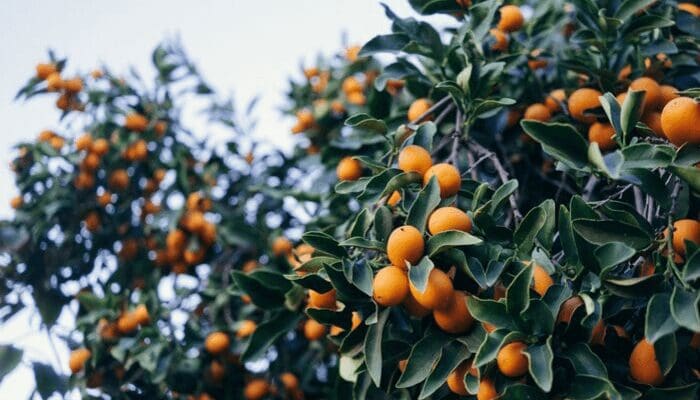
5. Skip bushes and trees that drop fruits and leaves
Just because a bush or tree species thrives in your part of the desert doesn’t necessarily mean you want it in your front yard—especially if it tends to drop lots of fruit, leaves, or flowers.
“You don’t want to plant a tree that’s going to drop leaves or fruit all over your yard and walkways, or you’ll be cleaning up all the time,” advises Trone.
“I have a little palm tree that drops purple plums and if I were selling my house right now, I’d have to hose down my patio every day. So pick plants or trees that don’t lose a lot of leaves, either in the winter time or summertime.”
Pulling out messy plants and trees makes our eco-smart desert curb appeal list due to the amount of water wasted by clean up efforts—not to mention the plastic garbage bags to used gather the yard waste.
Sure, when you’re just living in the house, you may only spray away and rake up these droppings once or twice a month. But when you’re planning to sell, you’ll be out there cleaning up your shedding shrubbery’s mess every time a buyer drops by for a showing.
So do yourself a favor and remove those messy plants and trees before listing your house for sale.
6. Add drama with elevation
Flat front yards don’t need to stay that way. And you don’t even need to truck in boulders to add height to your desert curb appeal. You can amp up the curb appeal with a little visual drama created by building up small hills in your yard.
Mimicking the foothills found at the base of desert mountains, these little mounds can then be covered with the same gravel or crushed stone covering the rest of your desert yard.
If the season and climate is right, you can even sprinkle drought-resistant wildflower seeds and have flower-covered mini hills for your front yard.
You don’t even need a pro landscaper to plot out where these little hills will go.
If the yard you’re working with is a bare, blank slate, simply plot out where the walkway to your front door will go, and then create random piles of dirt across the rest of the yard. You can create five to seven small hills, or just three larger hills of varying heights and sizes.
Since you’re emulating the naturalness of mother nature, there’s really no wrong way to create your elevation.
With these little hills adding visual interest to your curb appeal, you can get away with less plant life to draw the eye—which means you’ll be using even less water to keep your curb appeal fresh and sharp looking.
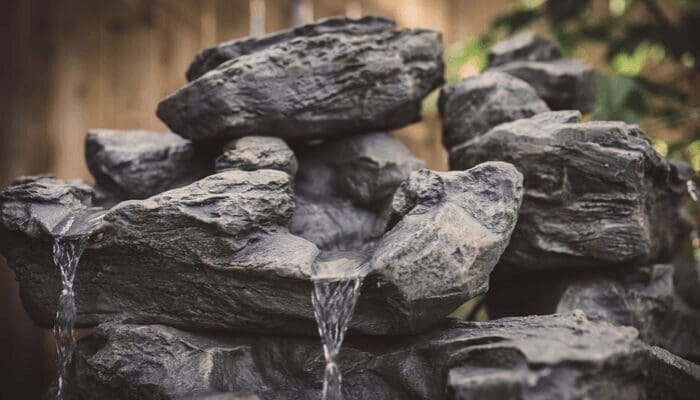
7. Install a water feature
“A water feature out front creates a serene, relaxing atmosphere which makes your curb appeal feel warm and welcoming,” says Trone.
“Fountains and other water features come in all shapes and sizes, but for me it’s more than just a look. When buyers walk up and hear the water feature, it’s just very soothing and leaves them with a good impression of the house.”
OK, water conservation is paramount in desert landscaping, so how can adding a water feature to your front yard be an eco-smart landscaping option?
The answer is simple: Self-contained fountains combat the barren, dry feel of a desert front yard with minimal impact on the environment the same way that lawns and plants do, but they require less water.
Most mid-sized outdoor fountains only require 3 to 10 gallons of water to work. Buy a self-contained fountain rather than one that constantly pulls fresh water from your plumbing. That way you’ll fill yourself with water that recirculates constantly and you’ll only need to add a little fresh water to keep it full every few days.
On the other hand, large grassy yards can suck up over 6,000 gallons every time you water your lawn. So, adding a water feature won’t waste more water than having plants, and it doesn’t even have to be expensive to add one.
Self-contained fountains with electric, plug-in pumps will only cost you around $100 to $500, depending on size and style. But it doesn’t even need to cost you that much if you create your own.
You can achieve all the benefits of a water feature with just a birdbath or wide, shallow container and an inexpensive solar-powered fountain for around $15. Plus, you won’t be using any extra electricity to run this one.
If you opt to DIY your fountain in a container, you can add an extra splash of foliage color by adding water plants to your potted pond.
Just pay close attention to the sprinkler head you choose to use in your DIY fountain. If your basin isn’t very big, wide, or deep, stick with the bubbler head which just bubbles the water instead of shooting it high into the sky.
Those sprinkler heads that fire fine streams of water high in the air aren’t the best choice for desert landscapes because the water evaporates more easily. Plus, if the container is too small, it may shoot all the water right out of the basin within a few hours.
8. Feature a no-water riverbed
One way desert landscapers create the impression of flowing water—without using any water at all—is by installing a dry creek bed across the landscaping.
A common feature in many desert front yards, these faux riverbeds are generally made with cantaloupe-sized river rocks artfully placed to line a trench dug across the yard in a shape that mimics the natural curves of a creek.
Some clever sellers even install small garden bridges over their dry riverbeds so that it can run across the full yard without interrupting the walkway to the front door.
These dry streambeds are useful in reducing erosion and can also help divert downpours away from your foundation during a desert monsoon rainstorm.
Just make sure that the trench you dig actually does run water away from your house, or you might wind up with a storm hazard that actually causes water to pool around your foundation.
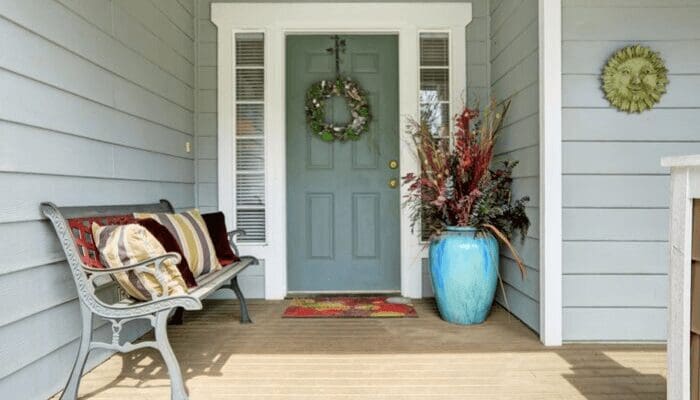
9. Create a serene seating area
Some desert homeowners rarely think about the condition of their front yard until it’s time to sell the house. That’s probably because they spend so little time enjoying a front yard that’s landscaped to be low maintenance.
Plus, the front yard probably isn’t looked at a whole lot the summer months when desert dwellers only give it a passing glance when dashing from their air-conditioned car into their cool house. But let’s not forget clear skies and cool temps of the wonderful fall and winter months—which is one of the big reasons many people move to the desert.
A seating area in your front yard is a wonderful way to immediately remind buyers of this wonderful weather. And it’ll plant the idea of spending many peaceful hours hanging outside to enjoy the desert curb appeal you worked so hard to achieve.
This seating area doesn’t need to be anything fancy. Maybe it’s a bench under a shade tree in the yard, a pair of Adirondack chairs on the front porch, or a porch swing on the patio.
Add a little color and texture with accessories like throw pillows and cushions. That’s another big benefit of desert dwelling—there’s little chance of rain to destroy your outdoor accessories.
10. Don’t go crazy with kitsch
Speaking of accessories, no desert curb appeal is complete without those little decorative details, like your house numbers, porch light, door hardware, and the mailbox.
While you may be living in the desert, there’s no reason why these accessories need to scream that fact with kitschy designs like a cactus-shaped mailbox.
“The style of your home’s décor accessories, like the mailbox and house numbers, depends on the style of the house,” advises Trone.
“Not every house in New Mexico is Pueblo-style, so going heavy on the kitschy Southwestern décor can feel like overkill, especially on a modern house. However, if your house already has a Southwestern flair, then you can go a little bit kitschy with the Western décor.”
OK, admittedly, this tip is less about being eco-friendly and more about avoiding eyesores—but hey, the environment can be healthy and look good, too!
Sell your house and save the environment, too!
It’s no secret that there’s a history of drought in the U.S.—and it’s the desert that’s hardest hit during water shortages.
But if you do your part to conserve water when planning your desert landscaping, you’ll come up with an eco-smart design that has the right curb appeal to help your house sell.
Header Image Source: (Simone Hogan/ Shutterstock)
